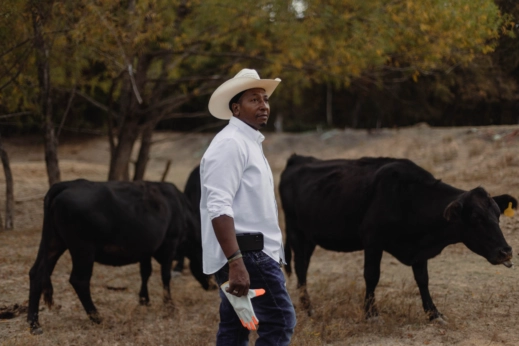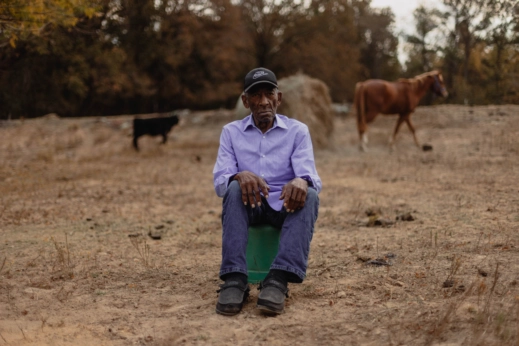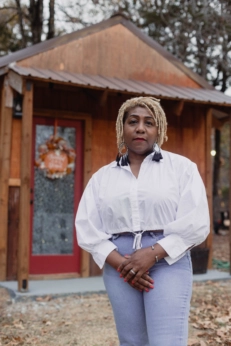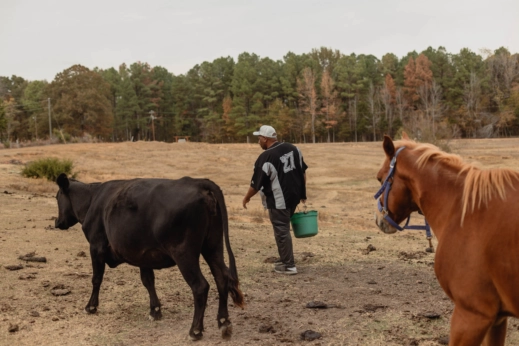The Biden administration has called USDA conservation programs a “linchpin” in the nation’s climate strategy.

When the U.S. Department of Agriculture denied Albert Johnson Sr.’s application for a farm loan in the mid-1980s, he went to a private lender who made him list as collateral all 20 of his cattle and his one bull.
“I stood a chance of losing my livestock,” Johnson wrote in a 1999 affidavit to receive part of a $2.3 billion federal settlement between Black farmers and the USDA.
Johnson, 81, who lives near Lexington, Mississippi, was among thousands deemed to not qualify for settlement money, his family said.
Against all odds, their family farm has persisted, part of the just 1 percent of remaining Black-owned farms in the United States. In an age of mechanized and industrialized agriculture, they face many challenges in operating a sustainable cattle farm—and there’s federal assistance to help with that.
But last month, Johnson’s children learned their application for federal conservation funding was turned down. They had sought up to $30,000 to dig a well and add cross fencing that would have allowed them to do rotational cattle grazing, which protects the soil from erosion.
“It was like ‘here again, another generation’,” said Charlene Gatson, 50, Johnson’s daughter. ”It was like history repeating itself.”
The Biden administration has called such USDA conservation programs a “linchpin” in the nation’s climate strategy, yet they remain vastly underfunded.
Just three out of 10 landowner applications for the two main programs, the Environmental Quality and Incentives Program (EQIP) and the Conservation Stewardship Program (CSP), were approved between 2018 and 2022. The majority of landowners are told to try again without advice on how to improve their odds.

Albert Johnson Jr. walks among the cattle on his family farm near Lexington, Mississippi, on Nov. 9, 2023. (Credit: Imani Khayyam for the Ag & Water Desk)
“These are farmers and landowners who want to do conservation on their farm. They want to do something we all seem to support—which is conserving natural resources,” said Jonathan Coppess, an associate professor and director of the Gardner Agriculture Policy Program at the University of Illinois.
Farmers want to improve the environment. Hundreds of thousands of them are applying. “And then you don’t get funding for no other reason than that funding is not sufficient in the program. The level of frustration and anger is pretty real,” said Coppess.
Although the Inflation Reduction Act provided $18 billion more for these in-demand conservation programs, some members of Congress want to claw back that money to pay for the 2023 Farm Bill.
High demand, not enough money
The flagship program of the USDA’s Natural Resources Conservation Service (NRCS) is the program the Johnsons applied for—EQIP—which reimburses agricultural and forestry producers 50 percent to 90 percent of the cost for fixing specific conservation problems and delivering environmental benefits, such as improving water or air quality, enriching soil or protecting against drought.
Between fiscal 2018 and fiscal 2022, the NRCS allocated $6.2 billion for EQIP, but that only covered 31 percent of the nearly 600,000 applications submitted during that five-year period, according to Investigate Midwest’s analysis of application and funding data the USDA provided The Gazette as part of a Freedom of Information Act request.
The Conservation Stewardship Program, created in the 2008 Farm Bill, provides annual payments to producers willing to improve conservation over a five-year period. The NRCS awarded $2.1 billion from fiscal 2018 through fiscal 2022, which covered just 28 percent of applications nationwide.
“EQIP and CSP are working lands programs so they are doing conservation on land that is continuing to produce crops,” Coppess said.
Programs face criticism, but remain the main federally supported solution
Modern agriculture takes a toll on soil and water. Programs like EQIP and CSP are intended to mitigate the damage. A 2020 NRCS report showed EQIP conservation from 2014-2018 increased soil and carbon retained in farm fields as well as provided wildlife habitat.
“Practices funded through EQIP to address forest health and watershed protection on non-industrial private forest land also sequester carbon,” the report found.
The most popular requests for EQIP and CSP funds vary by state. In Iowa and Wisconsin, where corn and soybeans grow, cover crops were by far the most-funded EQIP practice from 2017 through 2020, according to an analysis from the Environmental Working Group. But in Mississippi, with a more diverse farming mix including poultry, livestock and cotton, the EQIP practices that got the most funding were for fencing, grade stabilization structures and irrigation.
Some environmental groups have criticized EQIP for earmarking 50 percent of all funding for livestock practices, Coppess said. Although the U.S. has the world’s largest fed-cattle industry and livestock make up half or more of some states’ ag exports, what if your state isn’t big into pork or beef? Does that mean you get less money? There also are fears it will encourage more large-scale animal production, which can produce large amounts of waste that threatens water sources.
The NRCS allocates money to each state for EQIP and CSP contracts. States then distribute the cash to counties or manage the funds at the state level.
To decide how to spend the limited pot of money for conservation programming, local NRCS officials rank applications on a handful of factors, including how much the practice or activity costs, the magnitude of environmental benefits that could be achieved and how well the practice or activity proposed fits with “national priority resource concerns,” the NRCS reported.
“The ranking process was developed to try to be fair to everyone,” said Scott Cagle, assistant state conservationist for partnerships with the Iowa NRCS. But there are winners and losers and some producers drop out if they don’t get funded right away, Cagle said.
“We run into instances where producers signed up, the process takes too long sometimes and they give up,” he said.
Outreach to Black landowners, others who are underserved
The Johnson family is raising cattle on about 15 of the 200 acres they own near Lexington, Mississippi. During long spells without rain, the grass dries up and the Johnsons have to buy hay. Then the pond dries up and they have to use a hose from the house to water the cows, Gatson said.

Albert Johnson Sr. sits on a feed pail in the pasture of his family farm near Lexington, Mississippi, on Nov. 9, 2023. In October, he learned his children were denied funding through the federal Environmental Quality and Incentives Program because there isn’t enough money. (Credit: Imani Khayyam for the Ag & Water Desk)
If they got EQIP money, they would install cross fencing that would allow them to move cattle around, so plants can regrow between grazings and better protect the soil from erosion. A new well to provide reliable water would cost as much as $20,000.
“We need funding just for the cows to survive,” Gatson said.
The Mississippi NRCS suggested in a Oct. 6 denial letter that the Johnsons “defer” their EQIP application, which puts it back in the pile for the next funding cycle. But Gatson wants to know why their project didn’t rank higher so she can improve the application for next time.
“Could you tell us why some were funded and some were not?” she asked.
NRCS offices across the country have been trying to staff up to provide faster distribution of funds and more help for applicants. A workload analysis for Mississippi NRCS says they need another 55 to 60 employees to meet the need there.
Mississippi conservation officials have been expanding outreach to small producers, including those who haven’t traditionally gotten funding.
“If you look at Mississippi, it has the highest percentage of Black landowners in the nation and that’s around 10 percent,” said James Cummins, executive director of Wildlife Mississippi, a nonprofit that works toward habitat restoration and conservation policy in the state. “We want to see a percentage (of new conservation money) going to help historically underserved producers to help them maintain their family’s land and improve their natural resources.”
Mississippi, a state where agriculture is the No. 1 industry, submitted a whopping 10 percent of all EQIP and CSP applications from fiscal 2018 through fiscal 2022. But despite having the highest number of applications in both programs, only 14 percent of its CSP applications were approved, making it the state with the lowest approval rate relative to its application volume. In the case of EQIP, the state had an approval rate of just 21 percent.

Charlene Gatson, seen Nov. 9, 2023, on her family’s farm near Lexington, Mississippi, was frustrated when her family’s application to the federal Environmental Quality and Incentives Program was denied because the program doesn’t have enough money. (Credit: Imani Khayyam for the Ag & Water Desk)
Noemy Serrano is assistant policy director at Michael Fields Agricultural Institute who also works for Wisconsin Women in Conservation, which helps women farmers figure out conservation programs like NRCS. She said recently a farmer who’d received EQIP funding before was confused about whether she could apply again.
“That speaks to the details,” Serrano said. “Even folks that have already applied and been funded through the program sometimes don’t fully understand how it works and how to move forward with it.”
According to USDA data, Wisconsin funded 37 percent of EQIP applications and 35 percent of CSP applications received in fiscal year 2022.
In a perfect world, the NRCS would work with each farmer to make their application more likely to be funded, advocates said.
But because the NRCS staff are so busy, “instead of going out and adding different projects to these applications…they’re not adding that on, because it means more work,” said Sara George, who grows specialty crops near Pepin, Wisconsin.
Cash infusion in jeopardy
Conservation advocates hope a federal cash infusion will reduce the backlog of unfunded projects.
The Inflation Reduction Act, signed by President Joe Biden in August 2022, provides $8.45 billion more for EQIP and $3.25 billion more for CSP starting this year and building through fiscal 2026. This could potentially fund hundreds of thousands more applications. There’s another $300 million to quantify greenhouse gas sequestration.

Herman Johnson carries feed to cattle on his family farm near Lexington, Mississippi, on Nov. 9, 2023. (Credit: Imani Khayyam for the Ag & Water Desk)
“We know nationwide that IRA funds will increase” in 2024, said Jamie Alderks, assistant state conservationist for financial assistance programs with the Illinois NRCS. “IRA funds will assist in meeting some of the unmet demand.”
But Republicans in the U.S. House of Representatives want to repurpose that IRA conservation money to help pay for the Farm Bill, which expired in October without being renewed. House Agriculture Chairman Glenn Thompson suggested cutting $50 billion, mostly to climate change and public nutrition programs, to pay for other agriculture programs, such as crop insurance, The Hill reported.
In an Oct. 23 letter published by Politico, 24 Democrats on the House Agriculture Committee pushed back against the idea: “Moving the IRA funds from conservation would be denying farmers the support they need and want.”
Brittney J. Miller of the Gazette contributed to this story, which is a product of the Mississippi River Basin Ag & Water Desk, an independent reporting network based at the University of Missouri in partnership with Report for America, with major funding from the Walton Family Foundation.